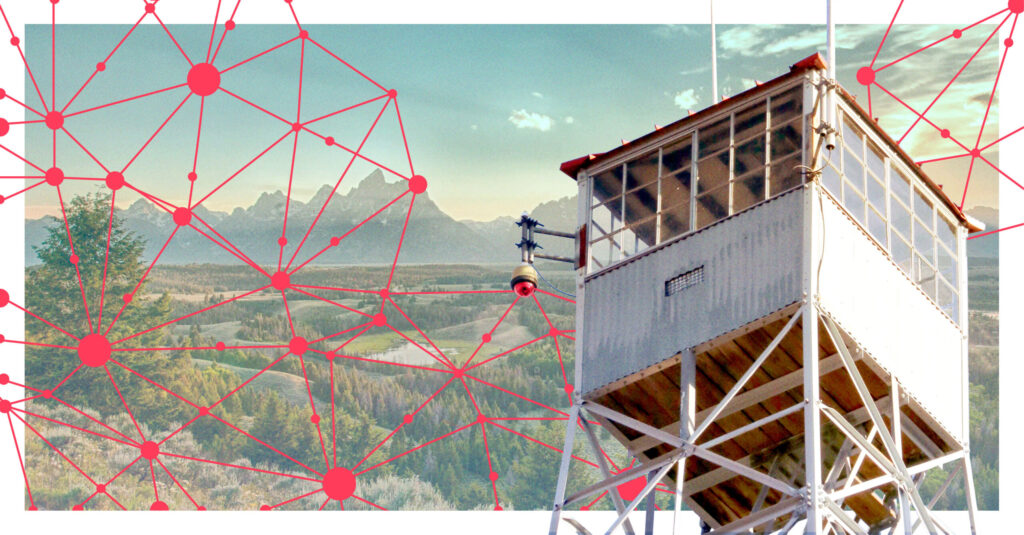ALERTWildfire: How Data Is Fighting Wildfires in the West
Natural disasters are unmistakable reminders of how powerful the forces of nature are. They devastate communities and their impacts are exacerbated by climate change. Wildfires are a particularly clear example. The 2019-2020 Australian bushfires saw a historic 42 million acres burned, and a record-breaking fire season in California saw three times more land burned in 2021 than 2020, the previous record-holding year.
To learn more about these fires, public and private entities are leveraging data to study the behaviors of wildfires. ALERTWildfire, born from the ashes of the Tubbs Fire, is one such organization hoping to leverage data to better understand wildfires, improve response time, and — most importantly — save lives and the landscape. ALERTWildfire is a consortium of three universities — the University of Nevada, Reno, University of California San Diego, and the University of Oregon, and provides access to state-of-the-art data and video of wildfire activity.
Perfect fire storm
While climate change directly and indirectly impacts nearly every aspect of life, wildfires have grown significantly worse due to a warming planet.
The size and speed of these fires present a serious challenge for fire watchers. With fires moving at unprecedented speeds, an acre can be burned in just five seconds. The harsh timeline of a growing wildfire means that even the 198 active fire watch towers in CA, aerial coverage, and support from local community volunteers are under immense pressure to provide accurate intelligence.
These challenges are part of what ALERTWildfire is attempting to address. By leveraging a network of more than 800 cameras, the organization uses a variety of technologies to identify, analyze, and alert to wildfires in California, Nevada, Oregon, Washington, Idaho, and Utah.
Dr. Neal Driscoll is a professor of geology and geophysics at UC San Diego and co-director of ALERTWildfire. He says when it comes to wildfire prevention, timing is of dire importance. “Fires all start small,” said, “but when the wind blows, they just grow so quickly. It’s hard to stop fires when they’re the size of the Dixie Fire. If we get on these fires in the incipient phase, we have a better chance at saving lives,” he said.
Upgrading the toolkit
The core of ALERTWildfire’s operation is a network of pan-tilt-zoom cameras, which offer nearly 360 degrees of coverage from a vantage point, like a repurposed fire watch tower. These video feeds are streamed directly to CalFire departments in the local counties, giving first responders real-time insight. Simultaneously, the video data are fed into several machine learning algorithms to train AI to do the same work.
“Computer vision is essential in a project dealing with image data,” said Johnathan Klingspon, research assistant at the UC San Diego Drone Lab. “We have a lot of machine learning work in identifying smoke plumes, and then we’re combining that with camera extrinsics to map these fires onto our digital twin of California in real time.”
“We can use that to estimate biomass in the path of the fire, and, ultimately, help coordinate firefighting efforts in real time,” said Klingspon.

The computer vision technology is also being trained across a variety of environments, meaning that each AI model must be trained on the “visual language” of their respective regions. Through this layered system, ALERTWidfire provides constant surveillance on the hotbeds of wildfires across the western United States.
These visual data are combined with other sources, such as wind speeds, humidity levels, eyewitness accounts, and others to offer a holistic approach to fire monitoring. For first responders, the technology represents a powerful, sophisticated tool that will help them manage fires and protect those in the path of fires. More data means more insight, which helps in the planning of measured responses. Based on the data, fire fighters know how quickly a fire is spreading, what equipment is required, and how many units and people are needed to respond. This more precise management of resources can ease the burden and keep fire departments prepared for the inevitable breakout of larger fires.
More than first response
The information collected by ALERTWildfire is doing more than just watching for fires, though. It’s empowering science of all kinds. In a recent interview with Western Digital, Dr. Falko Kuester, ALERTWildfire team member and professor at the Jacobs School of Engineering at UC San Diego, spoke of using the data to create a “digital twin” of California.
Using visual data, Dr. Kuester and his lab have constructed a digital facsimile of California, one which mirrors its geography, topography, and more. This model is empowering more research on wildfires. Kuester notes that there is still so much we don’t know about wildfire behavior, and trying to study or replicate the conditions is prohibitively dangerous. But by using all the data at its disposal, ALERTWildfire is better able to understand how they burn, what conditions can lessen or heighten fire risks, and how response and containment efforts could be improved. He noted this model could be expanded to understand other macro-scale phenomenon on the state, such as tsunamis or earthquakes.

Though the data modeling isn’t publicly available, the video feeds that are at the heart of ALERTWildfire are. On its website, all video feeds are open to the public, meaning locals can watch cameras for their county. This itself encourages and improves the citizen activism that CalFire relies on ALERTWildfire to assist them in monitoring for fires. Additionally, it also means that a wealth of data is available for people to study and leverage themselves.
“In the ALERTWildfire camera network we have almost 900 cameras deployed,” said Eric Lo, a field robotics and cyber infrastructure engineer with ALERTWildfire, in an interview. “Each camera, on average, gives us a new image every one-and-a-half seconds.”
Cameras and sensors are constantly being added to the system too. At the current system scale the sensor network captures 54 million images per day, adding approximately 15 terabytes of data per day, or 5.4 petabytes per year.
“The key aspect we needed for our storage cluster was that the data be accessible. We have 16 servers with 60 hard drives each which all adds up to 14.4 petabytes of hard drive space,” Lo said. Because of the scope and size of the data involved in the project, ALERTWildfire partnered with Western Digital to provide the much-needed storage space.
The project now enters its next storage phase with a new, state of the art, custom tailored datacenter. Due to the immense needs of the project, the team is employing a variety of storage solutions to capture the valuable data. The data center will include about 1,150 Ultrastar HC550 18TB drives with a total capacity of more than 20 petabytes, with the WD Purple 1TB micro SD cards in the cameras themselves.
Public access to such a massive dataset also encourages citizen science, empowering collective action to a challenge that people all over the western U.S. face together.
While the conditions for wildfires are not likely to improve any time soon, resilience and capacity for response and suppression is already. Armed with data and knowledge, first responders, public servants, volunteers, academics, and laypeople alike are all empowered to take fire season into their own hands to protect themselves, their communities, and their state’s natural beauty.




